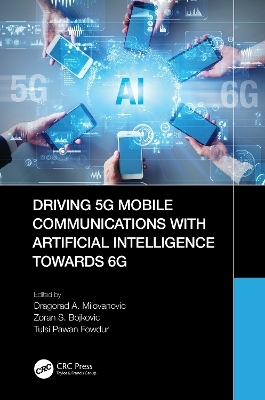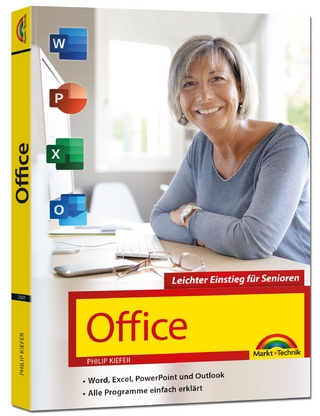
Driving 5G Mobile Communications with Artificial Intelligence towards 6G
CRC Press (Verlag)
978-1-032-07124-4 (ISBN)
Driving 5G Mobile Communications with Artificial Intelligence towards 6G presents current work and directions of continuous innovation and development in multimedia communications with a focus on services and users. The fifth generation of mobile wireless networks achieved the first deployment by 2020, completed the first phase of evolution in 2022, and started transition phase of 5G-Advanced toward the sixth generation. Perhaps one of the most important innovations brought by 5G is the platform-approach to connectivity, i.e., a single standard that can adapt to the heterogeneous connectivity requirements of vastly different use cases. 5G networks contain a list of different requirements, standardized technical specifications and a range of implementation options with spectral efficiency, latency, and reliability as primary performance metrics. Towards 6G, machine learning (ML) and artificial intelligence (AI) methods have recently proposed new approaches to modeling, designing, optimizing and implementing systems. They are now matured technologies that improve many research fields significantly.
The area of wireless multimedia communications has developed immensely, generating a large number of concepts, ideas, technical specifications, mobile standards, patents, and articles. Identifying the basic ideas and their complex interconnections becomes increasingly important.
The book is divided into three major parts, with each part containing four or five chapters:
Advanced 5G communication
Machine learning-based communication and network automation
Artificial Intelligence towards 6G
The first part discusses three main scenarios and standard specification of 5G use cases (eMBB, URLLC, mMTC), vehicular systems beyond 5G, and efficient edge architecture on NFV infrastructure. In the second part, different AI/ML-based methodologies and open research challenges are presented in introducing 5G-AIoT artificial intelligence of things, scheduling in 5G/6G communication systems, application of DL techniques to modulation, detection, and channel coding as well as 5G Open Source tools for experimentations and testing. The third part paved the way to deployment scenarios for different innovative services including technologies and applications of 5G/6G intelligent connectivity, AI-assisted eXtended Reality, integrated 5G-IoT architecture in next-generation Smart Grid, privacy requirements in a hyper-connected world, and evaluation of representative 6G use cases and technology trends.
The book is written by field experts from Europe and Mauritius who introduce a blend of scientific and engineering concepts covering this emerging wireless communication era. It is a very good reference book for telecom professionals, engineers, and practitioner in various 5G vertical domains and, finally, a basis for student courses in 5G/6G wireless systems.
Dragorad Milovanovic received the Dipl. Electr. Eng. and Magistar degree from the University of Belgrade, Serbia. From 1987 to 1991, he was a Research Assistant and PhD researcher from 1991 to 2001 at the Department of Electrical Engineering, where his interest includes simulation&analysis of digital communications systems. He has been working as R&D engineer for DSP software development in digital television industry. Also, he is serving as an ICT lecturer medicine/sports informatics and consultant in development standard-based solutions. He participated in research/innovation projects and published more than 300 papers in international journals and conference proceedings. He also, co-authored reference books/chapters in multimedia communications published by Prentice Hall, Wiley, CRC Press (2009, 2020), Springer and IGI Global. Present projects include adaptive coding of 3D-Video and immersive media, intelligent connectivity integration&interoperability, 5G/6G multimedia wireless communication. Zoran Bojkovic is full professor of Electrical Engineering University of Belgrade, Serbia, Life Senior Member of IEEE, full member of Engineering Academy of Serbia, member of Scientific Society of Serbia, member of Athens Institute for Education and Research ATINER. He was and still is visiting professor worldwide. He is author/co-author of more than 500 publications: monographies, books (Prentice-Hall, Wiley, McGraw Hill, Springer, CRC Press Taylor & Francis Group, IGI GLOBAL, WSEAS Press), book chapters, peer-reviewed journal, conference and symposium papers. Some of the books have been translated in China, India, Canada, Singapore. His research focuses on computer networks, multimedia communications, green communications, 5G and beyond. He is a highly regarded expert in the IEEE, contributing to the growth of communication industry and society reviewing process in many journals as well as organizing special sessions and being General Chair and TPC member at numerous conferences all over the world. He is also serving as editor-in-chief and associate editor of several international journals such as World Scientific and Engineering Academy and Society (WSEAS), North Atlantic University Union (NAUN), and International Association of Research and Science (IARAS). Pawan Fowdur, received his BEng (Hons) degree in Electronic and Communication Engineering with first class honours from the University of Mauritius in 2004. He was the recipient of a Gold medal for having produced the best degree project at the Faculty of Engineering in 2004. In 2005 he obtained a full-time PhD scholarship from the Tertiary Education Commission of Mauritius and was awarded his PhD degree in Electrical and Electronic Engineering in 2010 by the University of Mauritius. He is also a Registered Chartered Engineer of the Engineering Council of the UK, member of the Institute of Telecommunications Professionals of the UK and the IEEE. He joined the University of Mauritius as an academic in June 2009 and is presently an Associate Professor at the Department of Electrical and Electronic Engineering of the University of Mauritius. His research interests include Mobile and Wireless Communications, Multimedia Communications, Networking and Security, Telecommunications Applications Development, Internet of Things and AI. He has published several papers in these areas and is actively involved in research supervision, reviewing of papers and has been the General Co-Chair two international conferences.
PART 1 Advanced 5G Communication. 1. 5G-Advanced Mobile Communication: New Concepts and Research Challenges. 2. 5G-Advanced Mobile Broadband: New Multimedia Service Platform 3. 5G-Ultrareliable and Low-Latency Communication in Vertical Domain Expansion. 4. Vehicular Systems for 5G and beyond 5G:
Channel Modelling for Performance Evaluation. 5. Distribution of NFV Infrastructure Providing Efficient
Edge Computing Architecture for 5G Environments. PART 2 Machine Learning-Based Communication and Network Automation. 6. 5G-AIoT Artificial Intelligence of Things: Opportunity and Challenges. 7. Machine Learning-Based Scheduling in 5G/6G Communication. 8. Application of Deep Learning Techniques to Modulation and Detection for 5G and beyond Wireless Systems 9. AI-Based Coding for 5G/6G Communications PART 3 Artificial Intelligence towards 6G. 10. Enabling Technologies and Applications of 5G/6G-Powered
Intelligent Connectivity. 11. AI-Assisted Extended Reality Toward the 6G Era: Challenges and Prospective Solutions. 12. An Integrated 5G-IoT Architecture in Smart Grid Wide-Area Monitoring, Protection, and Control: Requirements, Opportunities and Challenges. 13. Privacy Requirements in a Hyper-Connected World:
Data Innovation vs. Data Protection.14. Evaluation of Representative 6G Use Cases: Identification of Functional Requirements and Technology Trends.
| Erscheinungsdatum | 20.03.2023 |
|---|---|
| Zusatzinfo | 58 Tables, black and white; 150 Line drawings, black and white; 150 Illustrations, black and white |
| Verlagsort | London |
| Sprache | englisch |
| Maße | 156 x 234 mm |
| Gewicht | 811 g |
| Themenwelt | Mathematik / Informatik ► Informatik |
| Technik ► Elektrotechnik / Energietechnik | |
| Technik ► Nachrichtentechnik | |
| Technik ► Umwelttechnik / Biotechnologie | |
| ISBN-10 | 1-032-07124-9 / 1032071249 |
| ISBN-13 | 978-1-032-07124-4 / 9781032071244 |
| Zustand | Neuware |
| Haben Sie eine Frage zum Produkt? |
aus dem Bereich


